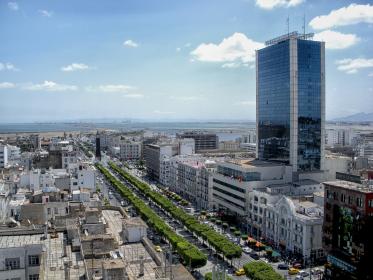TUNISIA'S TEXTILE SECTOR RECOVERS
German suppliers can benefit from production expansions
Tunis (GTAI) - After difficult years, Tunisia's textile sector is recovering. Exports and foreign investment are on the rise again. Production is for export, especially to Europe.
At the end of October 2018, the Swiss auditing group SGS reported its expanded testing capacity for textiles in Tunisia. This was in response to the increased demand from producers producing for the world market in Tunisia. The sector has not been doing well in recent years. Even before the revolution in 2011, competitive pressure from Asian producers had left its mark, especially after the expiry of the multi-fiber agreement in 2005. According to the FTTH (Fédération Tunisienne du textile et de l'habillement), more than 400 companies have left the country since 2011 and 40,000 jobs have been lost.
Now positive news are coming: In 2018, for example, the German Gonser Group opened its fifth production facility in Tunisia. In total, foreign direct investments in the first six months of 2018 amounted to Tunisian Dinar (tD) 24.9 million (approx. EUR 7.5 million), 1 tD = approx. EUR 0.301as of 11. 07.), more than twice as high as in the corresponding period of the previous year. The fact, that the number of new created jobs as a result has risen much less, can be seen as confirmation of the structural change: Away from simple mass production to higher-value production.
A high level of employee training is also decisive for this. The Sartex company shows how this can be ensured. In 2014, the Tunisian company opened a training center, in which some 500 Tunisians have already been trained and most of them were hired by Sartex. The company was supported by the Gesellschaft für Internationale Zusammenarbeit (GIZ) and the Centre d'Orientation et de Reconversion Professionnelle (CORP) of the AHK Tunisia.
During the visit of Federal Development Minister Müller in October 2018, an agreement was signed on the establishment of a training center in EL Alia in the Bizerte governorate. Among others the German company van Laack is producing in the region. A total of 180,000 Tunisians now work in the textile sector, which accounts with that for about 40 percent of industrial jobs.
Wage increases in two steps
More than one year after its foundation, FTTH has established itself as the interest representative of textile companies. In 2017 the company split from the employers' association UTICA (Union Tunisians de l'Industrie, du Commerce et de l'Artisanat), not least because the envisaged general wage increases for the company's own industrial sector were considered unworkable. But meanwhile, common ground and cooperation have been emphasized again, or FTTH describes itself as part of UTICA, with a high degree of autonomy.
An agreement has now also been reached with the Union Générale Tunisienne du Travail (UGTT). This provides for wage increases of 6.5 percent as of 1 January 2019 and 2020 respectively. This wage increases are thus likely to be lower than the inflation, provided that the forecasts for the inflation rate of around 7.5 percent for the current year 2018 will be that way. Currently, the minimum wage in Tunisia's textile and clothing industry for unskilled job starters is around EUR 129 (as of 07-11-2018) per 48-hour week.
Of the more than 1,600 textile companies, over 1,400 are producing exclusively for export. The target markets are clearly in Europe. More than 60 percent of exports went to France and Italy in 2016, with Germany in third place with about 11 percent. As the largest non-European customer, the USA was ranked ninth with less than one per cent. By joining the Common Market for Southern and Eastern Africa (COMESA), Tunisia aims to develop new markets. According to the Ministry of Commerce, bilateral talks are underway with several African countries to provide duty-free market access for Tunisian textiles.
Are Chinese investors discovering Tunisia as a location?
In addition to the relations with the African continent, relations with China could also change in the medium term. At the China-Africa Cooperation Forum held in Beijing in September 2018, Chinese textile companies expressed their interest in Tunisia as a production location. As wages have increased in China in the meantime, a relocation of production to certain sectors of the textile industry could prove useful for the European market.
Exports already increased in 2017. The trend seems to continue in 2018. In 2016 exports were USD 2.9 billion, in 2017 USD 3 billion (a significant increase due to the Dinar's decline in exchange rates (7 billion tD against tD 8.4 billion). According to the first announcements, exports to Europe in the first months of 2018 are expected to have increased again by 3.5 percent compared to 2017. Improving transport and customs clearance should be important for the further development of the textile sector. Especially the companies producing purely for export express this again and again. The textile sector in particular is dependent on short delivery times.
Meanwhile, FTTH is also working to improve the competitive position of Tunisian textile companies on their home market. This applies, for example, to the imports of used clothing for which stricter controls are being desired.
| Origin | 2015 | 2016 | 2017 |
| Total | 68.8 | 67.0 | 67.3 |
| Italy | 15.8 | 13.7 | 17.9 |
| China | 20.5 | 12.4 | 10.6 |
| France | 6.5 | 4.0 | 7.4 |
| Germany | 5.0 | 6.3 | 7.2 |
Note: Thailand was the third largest supplier in 2016, but fell behind in 2017. The table shows the four most important suppliers in 2017
Source: UN Comtrade
In addition to production expansions by German companies, German suppliers could also benefit if the recovery and, above all, structural changes will continue. While total imports of textile and leather machinery fell slightly from around USD 70 million to USD 67 million between 2015 and 2017, German deliveries increased from USD 5 million to USD 7.2 million. (JPS)
Further information on the Chinese commitment in Tunisia can be found online (German only): Link







